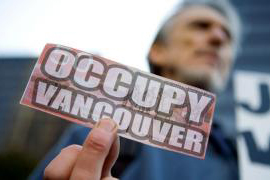
Early in the Canadian Occupy protests in October, Bank of Canada Governor Mark Carney described the movement as “constructive” – the understandable product of worsening income inequality. He was partly right. He should have said the protests were potentially constructive, but only if parties on both sides of the barricades open their minds about taxes, specifically the superior redistributive potential of consumption and value-added taxes (VAT) over income taxes. If you’re interested in closing the gap between rich and poor and you believe that only higher income taxes on corporations and the rich will do it, you’re defeating your own cause.
Let’s start with the complaint: income disparity. Both Carney and Finance Minister Jim Flaherty agree it’s getting worse in Canada. In an op-ed article published in several newspapers the day after the protests began, Mike Moffatt, an economist with the Richard Ivey School of Business, noted that Canada has fallen far down the ranks of developed countries by measures of income equality and that the gap between rich and poor here is widening faster than it is in the United States.
Serious problems require serious solutions, of course. That would exclude flaky ideas like “Smash Capitalism” and “End Ownership” (both suggested on protestors’ signs in Vancouver). Instead, Moffatt pointed out that countries with the least disparity of income tend to have moderate corporate taxes and high VATs. In Denmark, Sweden and Finland, where income disparity is low, the VAT rate averages 25%.
VATs such as Canada’s GST and the combined federal-provincial HST (in the provinces where it applies) are charged on the difference between the cost of inputs and the selling price at each stage in the manufacture and distribution of a product or service. VATs and sales taxes tend to be more efficient and harder to avoid than income taxes. Moffatt cited research by Stephen Gordon of Université Laval, which projects that a hefty increase in income taxes on the rich—say, 10 percentage points more on incomes higher than $500,000—would generate far less revenue than even a one-percentage-point HST increase. Despite the advantages of the HST touted by economists and governments, British Columbians voted to abolish their 12% HST in a referendum in August, although this will simply mean bringing back the province’s old sales tax and the federal GST.
Why are VATs and sales taxes so unpopular? One common critique is that they are regressive. On average, poor families spend a higher proportion of their income on consumption than rich families, who generally have surplus earnings to save. But if you measure a VAT or sales tax relative to total spending by individuals—the rich generally spend a lot more than the poor—those taxes actually look progressive.
VATs can also be tailored to soften or reverse any regressive impact. You can exempt or charge low rates on products such as groceries, and tax luxury goods more heavily. Political leaders can also direct VAT revenues to programs targeted at low-income groups.
In the end, however, it will probably be a lack of options that drives us to embrace VATs. This might happen if the fiscal crisis deepens. As Bruce Bartlett wrote in an article in Forbes late last year: “A VAT is never going to be seriously considered unless the need is overwhelming.” Perhaps it’s that sense of need that underscores the so-called 9-9-9 plan touted by Republican U.S. presidential candidate Herman Cain, in which he proposes to slash federal personal and corporate income tax rates to 9%, and make up for lost revenue with a 9% national sales tax.
Whatever we think of Cain’s plan, we probably won’t seize the VAT solution until deficits start driving inflation and interest rates higher, and income disparities get worse. It would be better to act now, rather than later. But that would take movement on both sides of the barricade.

